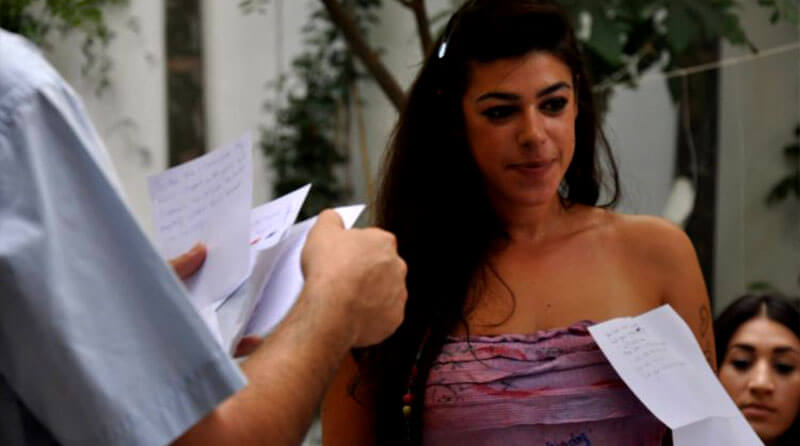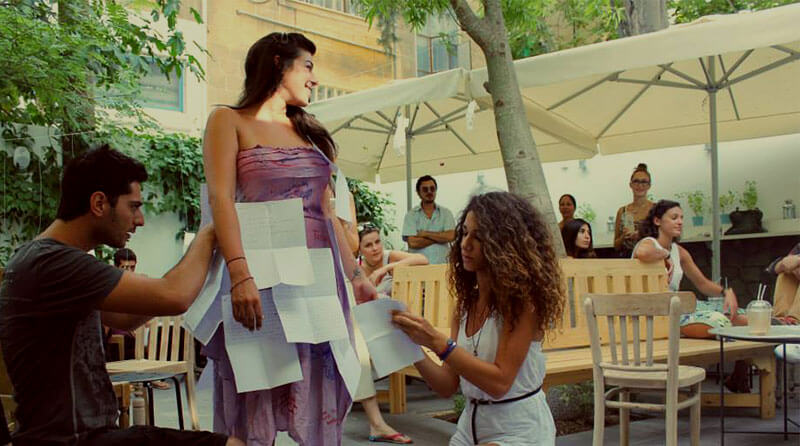Love Letters
Love Letters involves sharing private memories, exhibiting public histories, and uses audience participation and the act of storytelling.
Love Letters is an ongoing performance project initially conceived by live art practitioner and academic Yiota Demetriou.
The project combines aesthetics of performance and sound art/installation, and involves sharing private memories, exhibiting public histories, and uses audience participation and the act of storytelling.
The original form of the piece invited audience members to write anonymous love letters to a significant other using the four types of Greek love: Agape, Eros, Filia, Storge. In turn, the audience selected and read aloud other audiences' love letters (from the bank of letters collected from each performance); they inscribed the name of the sender and the addressee on the performer's dress and/or body and furthermore pinned the narrated letter onto the dress.
From being re-performed, the current love letters collection holds more than 200 audience letters. Past audiences' letters are reactivated in each performance, and new love letters are written and added to the collection.
Inspiration
The work was initially performed at the Performance and Live Art Platform (2012) in Cyprus as a performance happening. Since then, it has taken the shape of a performance lecture, a sound installation and a durational, processed-based performance installation. The performance's shape may have shifted several times, however the work's main content – which through every performance emerges from the very act of participation, engagement and interaction of the audience – remains unchanged. This ongoing piece has been performed more than five times in different countries across the EU and at renowned performance festivals and conferences such as: Performing Documents (2012), Performance and Live Art Platform (2012, 2014), Tempting Failure (2013, 2014), Latitude (2015), and iDocs (2016).
The performance's symbolic actions do not only intervene in the notion of "keeping" private memories by compelling the audience to participate in an exchange of them, but also by further witnessing others. This is realised by "exposing" their intimate and personal testimonies (with their consent).
Narrative
If, as psychologist Jerome Bruner (1990) reasoned, narrative is a cultural mediator that "mediates between the canonical world of culture and the more idiosyncratic world of beliefs, desires and hopes" (p. 52), then the stories written and told in Love Letters - even though they do not have a collective or empirical significance, still make evident how narrative is a vital component of the human mind, key to making sense of the world around us. In light of this, the contents collected work are types of candid cultural artefacts or resources that carry 'intangible' personal heritage. As Barthes (2002) suggested, "[...] the special dialectic of the love letter, both blank (encoded) and expressive (charged with longing to signify desire)" (p. 157), stories that are sometimes profound and intense, and other times are superficial and trivial are given existence through their mediation.
The action of writing a letter was used as a tool to evoke memories. The different set of praxis undertaken during the performance in Love Letters intervene further in the idea of 'keeping' private remembrances to oneself by having the audience engage with the performer and her dress in particular ways so that the memories shared, become attached with new environments, connotations and other ways of telling. These modes of engagement occur through two strands of audience-performer interaction: writing the letter and reading another aloud, pinning the narrated letter onto the dress and writing on the dress and the performer's body. The second additional layer comprises of noting: addressee names, memories, notes, streams of consciousness, a sentence, a word (specifically on the theme of love), which capture an experience of platonic, familial or lustful emotion, by inviting the audience to document these on the performer's body.
Presence and Absence
The dress worn in every performance is the same. It is 'stained' with past and present audiences' contributions, playing with the notions of presence and absence. As described the audience would note the name of the sender and the addressee on the garment and or the performer's body. Additionally, the dress also contains memo-type messages that people left on it, for others to see and perhaps to not see.
Thus, the dress is a crucial component of the performance. It becomes part of the audiences' recollections, not only as given traces of past written and narrative acts, but also as an in-between, a mediator, of what was said and what was lost. It most importantly becomes a vessel that embodies these people's intimate stories. In this sense, the dress witnesses the different tellings, shares a different type of intimacy with each and every audience member that has interacted with it. It is a technology that is physically embedded with their memories, as well as the cultural connotations it carries because of its material form. Thus, by having the audience pin the letters, it simultaneously works as a platform to exhibit these different stories and experiences, embodying the audience members' personal stories that were shared during each performance.

Project Goals
We are woking on redeveloping Love Letters as an interactive sound installation using creative technologies, making the the curation of the piece's content user-generative. Through this we will explore how the different types of interfaces used in the performance: body, skin and dress, can be used to communicate text-based narrative.
At the same time, through using sound-based tech, we are also investigating how pervasive technology can support reminiscing and facilitate a sustainability in performative settings such as storytelling practices. We aim to develop a prototype that will be showcased in a performance setting. Following this, we hope to donate the performance materials (costume and audience's contributions) to the Museum of Broken Relationships for preservation.
Impact
An article of the project has been published online in the Body, Space, Technology journal (Vol. 16, ISSN 1470-9120).
A showcase of the work-in-progress will take early this summer at the Pervasive Media Studio in Bristol. If you are interested in participating in this, please contact: p.demetriou@bathspa.ac.uk
The piece will be performed in Zagreb at the end of July 2017, as it has been commissioned by Museum of Broken Relationships in Croatia.
The final showcase of Love letters will be performed at Centrespace Gallery in Bristol at the end of the August 2017.
At the end of the project, the entire audience love letters collection will be donated to the Museum of Broken Relationships and will be added to their exhibition collection.
People involved
- Dr Yiota Demetriou (Performer/Lead Artist)
- Odysseas Pappas (Electronics Engineer)
- Stathis Kampylis (Composer/Sound Artist)
- Tarim (Creative Technologist)
- James Wheale (Artistic Assistant Producer)
Supporters
Vice in the Live Art Almanac Vol. 4
More information on the piece: yiotademetriou.com
